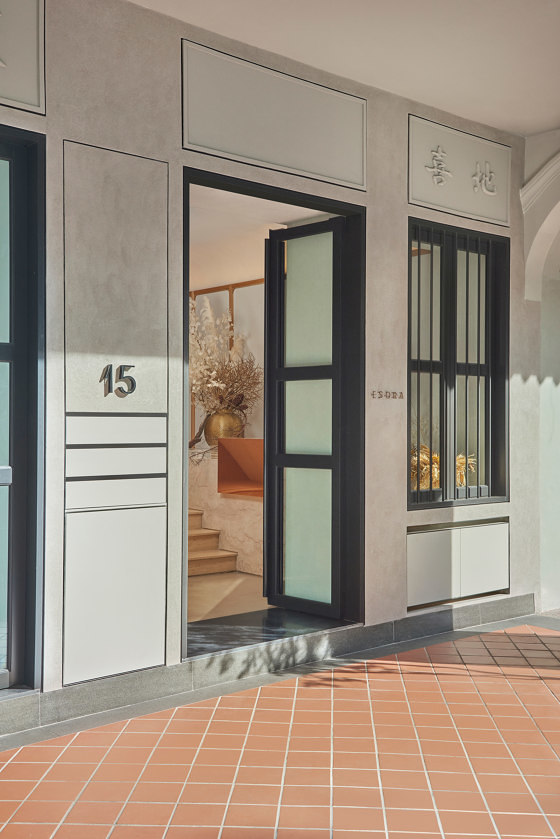Mount Foodie: 5 Japanese restaurants that are easy on the eye
Texto por Alun Lennon
25.09.19
Today's newest Japanese restaurants are feeding not only hungry stomachs but also design-hungry Instagram accounts.
Japanese cuisine relies as much on visual language and attention to detail as it does on enlivening the taste buds. And you could say the same about the design of the following, as we present five restaurants which also guarantee visitors a feast for the eyes.
Upon entering the 1st floor, the guest is met by a bright and sophisticated space, conveyed by the oak tabletops, chairs, partition panel walls and open plan of the floor. Photos: Courtesy of Norm Architects

Upon entering the 1st floor, the guest is met by a bright and sophisticated space, conveyed by the oak tabletops, chairs, partition panel walls and open plan of the floor. Photos: Courtesy of Norm Architects
×01
Sticks 'n' Sushi
London, England
2018
Project by Norm Architects
Norm Architects are behind the interior design of the first Sticks ‘n’ Sushi restaurant in London, located on King’s Road in the heart of chic and high-end Chelsea. A richly textured space where Scandinavian and Japanese aesthetics meet through an emphasis on natural materials and an overall sense of contemporary luxury.
. . .
The formal structure of the space appears as a faceted cave-like atmosphere which is cut and deformed to adapt to the various necessities of the restaurant. Photographer: Yoshihiro Koitani

The formal structure of the space appears as a faceted cave-like atmosphere which is cut and deformed to adapt to the various necessities of the restaurant. Photographer: Yoshihiro Koitani
×02
Oku Restaurant
Mexico City, Mexico
2018
Project by Michan Architecture
Oku is a Japanese restaurant located in the northeast of Mexico City, on the ground floor of a corporate office building on Prado Sur street. The kitchen and services of the space are placed in the back corner, opening up the rest of the layout for the reception, sushi bar as well as interior/exterior space for different types of seating layouts.
. . .
For the interior, Masquespacio got back to the age of traditional Oriental decoration in search of a strong unique identity that could make Kento stand out in a highly competitive market. Photographer: Luis Beltran

For the interior, Masquespacio got back to the age of traditional Oriental decoration in search of a strong unique identity that could make Kento stand out in a highly competitive market. Photographer: Luis Beltran
×03
Kento
Valencia, Spain
2018
Project by Masquespacio
Masquespacio presents Kento, their project for an Oriental food chain in Valencia, focused mainly on sushi and other specialties from the Japanese kitchen. Founded by Valencian entrepreneur Eduardo Hijlkema, the new chain counts on the consultancy of well-known chef and youtuber Taka Sasaki, and is the result of Hijlkema's wish to encourage a healthier lifestyle.
. . .
While the design is certainly inspired by Japanese interiors, it is reinterpreted here to avoid indulging in the cliche. Photographer: Read McKendree

While the design is certainly inspired by Japanese interiors, it is reinterpreted here to avoid indulging in the cliche. Photographer: Read McKendree
×04
Tsukimi
New York City, United States
2019
Project by Studio Tack
Tsukimi offers a modern take on kaiseki, a traditional multi-course Japanese dinner. The name “Tsukimi” literally translates to “moon viewing” and refers to a mid-autumn harvest festival honouring the moon when it is at its fullest and brightest.
. . .
The palette of materials is very restrained. A bright modern feel was desired, so predominantly light plaster and stone was used. Photographer: Jovian Lim

The palette of materials is very restrained. A bright modern feel was desired, so predominantly light plaster and stone was used. Photographer: Jovian Lim
×05
Esora Restaurant
Singapore, Singapore
2018
Project by Takenouchi Webb
Located in a heritage shop-house along Mohammed Sultan Road, the client's brief was to create a modern Japanese kappo-style restaurant. Kappo restaurants offer a multi-course meal left entirely up to the chef and means “to cut and cook”, an all-encompassing word for a less formal cuisine that emphasises the proximity between the diner and the chef who is cutting and cooking the food.
© Architonic


























